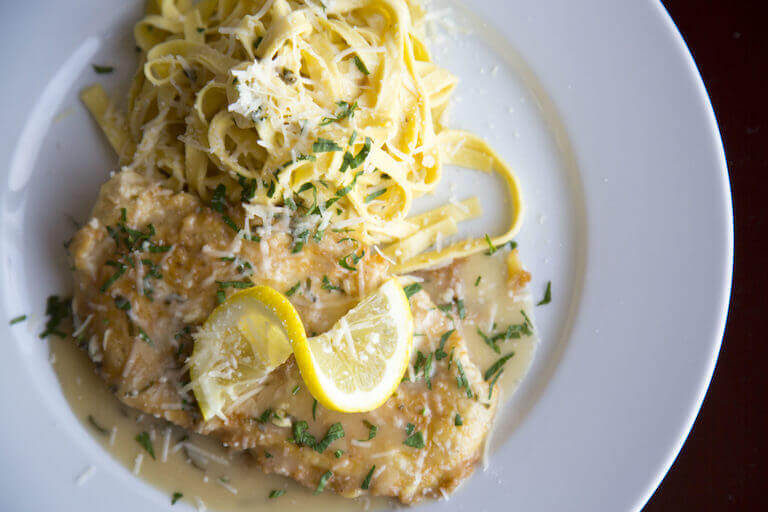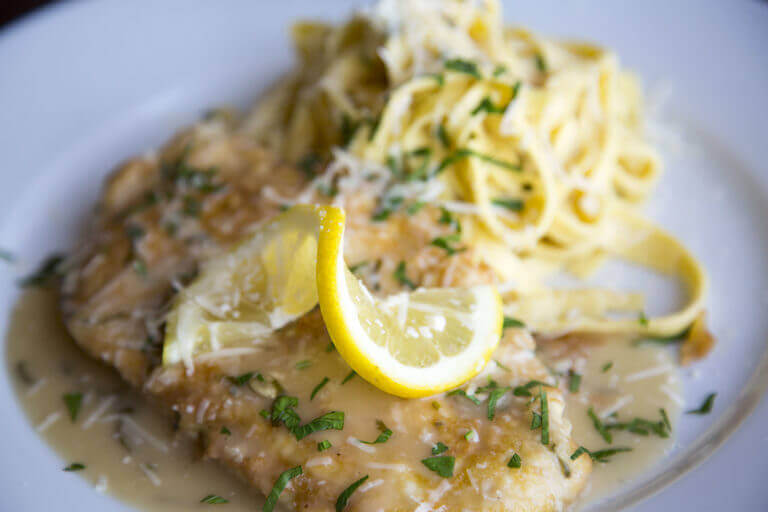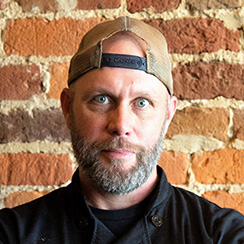An American dish with a French name and Italian ingredients. That’s chicken Francaise, for you! This simple pasta course is the perfect mix of rich and light ingredients. A lightly breaded chicken cutlet is sauteed and then cooked in a sauce loaded with the flavors of garlic, lemon, and wine. Serve it with a big heap of al dente fettuccine, some fresh parsley, and a pinch of lemon juice for the perfectly indulgent meal.
Follow along with our online culinary program instructor as he shows you how to make chicken Francaise from scratch in this video tutorial.
How to Make Chicken Francaise
Ingredients
4 chicken breasts
2 eggs
1 lemon
¼ cup avocado oil
½ oz flour
½ oz butter
½ cup white wine
1 ½ cups chicken broth
½ cup of freshly grated Parmesan cheese
1 garlic clove minced
Italian parsley
Kosher salt
Black pepper
Flour for dusting
Directions
1. Mix one cup of flour with salt and pepper to make a dredging mixture.
2. Using a meat meat mallet, pound the chicken breasts flat so that they are about ¼ inch thick.
3. Crack two eggs into a flat bowl, pierce the yolks with a fork, and scramble them slightly. Once they’re scrambled, add ¼ cup of Parmesan cheese.
4. Dredge the chicken breasts in the flour so they are coated very lightly.
5. Heat the quarter cup of avocado oil in a large fry pan on medium-high heat. When it is hot, run the chicken through the egg wash and place the chicken into the pan. Cook for one to two minutes on each side.
6. Remove the chicken from the pan, then add more oil and sauté the garlic. Slice the lemon into thin slices and add to the pan. Deglaze the pan with wine and reduce by half.
7. Add chicken broth to the pan. Combine the butter and flour to make a paste, then slowly add small amounts to the sauce, while whisking constantly. Once the sauce reaches the desired thickness, season with salt and pepper.
8. Return chicken breast to the sauce or spoon some of the sauce over plated chicken. Sprinkle with cheese and chopped parsley then serve immediately.

The History of Chicken Francaise
When Italian immigrants arrived in New York, they brought their family recipes and also began creating new dishes. The combination of lemon, white wine, and butter was a popular flavor combination. But the act of putting this sauce on pounded and dredged chicken breast was something new!
If you search any old classic Italian cookbook or head to Italy, you won’t find “Francaise” or the alternative “Francese” on any menu. That’s because despite this dish’s Italian origins, it’s rarely known outside of the United States.
Tips for Making a Perfect Chicken Francaise
Keep in Mind Oil Smoke Point
Olive oil provides a wonderful flavor that mixes well with the lemon butter sauce. However, it has a low smoke point. That means if you place it over high heat, it’s likely to smoke and add a burnt taste to your dish.
So instead of using all olive oil to fry your chicken cutlets, use avocado oil. Avocado oil has an extremely high smoke point (520º) so you can fry your chicken without fear of setting off the smoke alarms or burning the final product.
Don’t Worry if the Chicken Starts Sticking
When you first add your chicken to the pan, it may begin sticking. Don’t worry! As your flour and egg wash coating begins to turn into a nice golden brown crust, it will be easy to remove from the pan. With that in mind, don’t shake or move the chicken until a crust has formed.
Choose a Dry White Wine
Stay away from sweet white wines like Riesling and dessert wines. Instead, opt for drier options such as Pinot Grigio or Sauvignon Blanc. These wines add a nice flavor without providing overwhelming sweetness to the sauce.

Explore New Culinary Skills
If you’d like to learn more from professional chef instructors, why not explore culinary school? Escoffier’s Culinary Arts programs introduce students to kitchen fundamentals like ingredient selection and knife skills so students have a strong foundation. They may then dive into other topics like global flavors, entrepreneurship, and advanced cooking techniques.
“My education with Escoffier has really given me a good foundation. It has filled a resume gap; it’s filled a professional gap and a skills gap. It has helped me in all aspects of my culinary career.”*
Lance McWhorter, Online Culinary Arts Graduate
With both in-person and online programs, you may find that attending culinary school is more attainable than you once thought! To learn more about Escoffier’s programs, contact us today.
If you enjoyed this article, read these next:
- Different Knives and the Best Uses for Each One
- 7 Tips for Becoming a Faster Cook
- How to Perfectly Pair Pasta and Sauces
*Information may not reflect every student’s experience. Results and outcomes may be based on several factors, such as geographical region or previous experience.
This article was originally published on February 28, 2018, and has since been updated.

 “My education with Escoffier has really given me a good foundation. It has filled a resume gap; it’s filled a professional gap and a skills gap. It has helped me in all aspects of my culinary career.”*
“My education with Escoffier has really given me a good foundation. It has filled a resume gap; it’s filled a professional gap and a skills gap. It has helped me in all aspects of my culinary career.”*